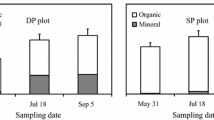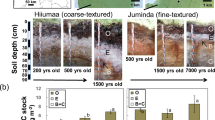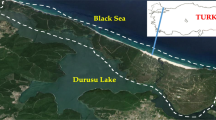Abstract
Maritime pine (Pinus pinaster) is the main tree cropping species in the Landes of Gascogne forest range in south western France. Soils are nutrient poor, sandy podzosols and site fertility is determined essentially by organic matter content and depth of water table, which is known to limit root growth. We hypothesised, with an ultimate goal of constructing a nutrient uptake model applicable to this region, that the organic top horizons together with the depth of the water table should be the most important parameters related to fine root distribution and presence of associated mycorrhiza. To test this hypothesis, we compared two adult Pinus pinaster stands, contrasting in depth of water table and soil fertility and evaluated fine roots (diameter ≤2 mm) of understory species and fine roots and ectomycorrhizal morphotypes of Pinus pinaster down to 1.2 m, using a soil corer approach. Total fine root biomass of Pinus pinaster was not significantly different between both sites (3.6 and 4.5 t ha−1 for the humid, respectively, dry site), but root distribution was significantly shallower and root diameter increased more with depth at the humid site, presumably due to more adverse soil conditions as related to the presence of a hardpan, higher amount of aluminium oxides and / or anoxia. Fine roots of Pinus pinaster represented only about 30% of total fine root biomass and 15% of total fine root length, suggesting that the understory species cannot be ignored with regards to competition for mineral nutrients and water. A comparison of the ectomycorrhizal morphotypes showed that the humid site could be characterised by a very large proportion of contact exploration types, thought to be more relevant in accessing organic nutrient sources, whereas the dry site had a significantly higher proportion of both long-distance and short-distance exploration types, the latter of which was thought to be more resistant to short-term drought periods. These results partly confirm our hypothesis on root distribution as related to the presence of soil mineral nutrients (i.e. in organic matter), point out the potential role of understory plant species and ectomycorrhizal symbiosis and are a valuable step in building a site-specific nutrient uptake model.
Similar content being viewed by others
References
Agerer R (2001) Exploration types of ectomycorrhizae – a proposal to classify ectomycorhizal mycelial systems according to their patterns of differentation and␣putative ecological importance. Mycorrhiza 11:107–114
Aquino M T, Plassard C (2004) Dynamics of ectomycorrhizal mycelial growth and P transfer to the host plant in response to low and high soil P availability. FEMS Microbiol Ecol 48:149–156
Augusto L, Badeau V, Arrouays D, Trichet P, Floc J-L, Jolivet C, Merzeau D (2006) Using a meta-analysis approach to characterize the physico-chemistry of soils at the regional scale. Example for the forest soils of the Massif Landais [in French, Abstract, Tables and Figures in English]. Etude Gest Sols, (in press)
Balandier P, Collet C, Miller JH, Reynolds PE, Zedaker SM (2006) Designing forest vegetation management strategies based on the mechanisms and dynamics of crop tree competition by neighbouring vegetation. Forestry 79:3–27
Bauhus J, Messier C (1999) Soil exploitation strategies of fine roots in different tree species of the southern boreal forest of eastern Canada. Can J For Res 29:260–273
Bell TL, Adams MA (2004) Ecophysiology of ectomycorrhizal fungi associated with Pinus spp. in low rainfall areas of Western Australia. Plant Ecol 171:35–52
Berntson GM (1994) Modelling root architecture: are there tradeoffs between efficiency and potential of resource acquisition? New Phytol 127:483–493
Bert D, Danjon F (2006) Carbon concentration variations in the roots, stem and crown of mature Pinus pinaster (Ait.). For Ecol Manage 222:279–295
Bonneau M (1995) Fertilisation des forêts dans les pays tempérés. Théorie, bases du diagnostic, conseils pratiques, réalisations expérimentales. ENGREF, Nancy, 367 pp
Burbridge NT (1936) Root development in Pinus pinaster and the seasonal variation of its mycorrhizae. Aust For 1:32–40
Burch WH, Jones RH, Mou P, Mitchell RJ (1997) Root system development of single and mixed plant functional type communities following harvest in a pine-hardwood forest. Can J For Res 27:1753–1764
Chaperon H, Crémière L (1994) Manuel pratique de sylviculture du Pin maritime. AFOCEL, 145 pp
Cheaïb A, Mollier A, Thunot S, Lambrot C, Pellerin S, Loustau D (2005) Interactive effects of phosphorus and light availability on early growth of maritime pine seedlings. Ann For Sci 62:575–583
Clemensson-Lindell A, Persson H (1995) Fine-root vitality in a Norway spruce stand subjected to various nutrient supplies. Plant Soil 168–169:167–172
Comas LH, Bouma TJ, Eissenstat DM (2002) Linking root traits to potential growth rate in six temperate tree species. Oecologia 132:34–43
Conjeaud C, Scheromm P, Mousain D (1996) Effects of phosphorus and ectomycorrhiza on maritime pine seedlings (Pinus pinaster). New Phytol 133:345–351
Cornu A (1994) Profil de répartition de la masse racinaire de Molinia caerulea (L.) Moench en sous-bois d’un peuplement de Pin maritime. Rapport de stage de DEUG. INRA Pierroton. 16 pp
Cucchi V, Meredieu C, Stokes A, Berthier S, Bert D, Najar M, Denis A, Lastennet R (2004) Root anchorage of inner and edge trees in stands of Maritime pine (Pinus pinaster Ait.) growing in different podzolic soil conditions. Trees-Struct Funct 18:460–466
Danjon F, Fourcaud T, Bert D (2005) Root architecture and wind-firmness of mature Pinus pinaster. New Phytol 168:387–400
Dunbabin VM, Diggle AJ, Rengel Z, van Hugten R (2002) Modelling the interactions between water and nutrient uptake and root growth. Plant Soil 239:19–38
George E, Seith B, Schaeffer C, Marschner H (1997) Responses of Picea, Pinus and Pseudotsuga roots to heterogeneous nutrient distribution in soil. Tree Physiol 17:39–45
IFN (2005) Inventaire Forestier National [online]: National Forestry Inventory data available from http://www.ifn.fr for the four forest regions comprising the Massif of Gascogne [cited on August 5th 2005]. Reference years for measurements: 1998, 1999 and 2000. Total forested surface = 857400 Ha, of which 747390 Maritime Pine
Jany J-L, Martin F, Garbaye J (2003) Respiration activity of ectomycorrhizas for Cenococcum geophilum and Lactarius sp. in relation to soil water potential in five beech forests. Plant Soil 255:487–494
Jolivet C (2000) Le carbone organique des sols des Landes de Gascogne. Variabilité spatiale et effets des pratiques sylvicoles et agricoles. PhD-Thesis Université de Bourgogne and INRA d’Orléans. 313 pp
Jolivet C, Arrouays D, Lévèque J, Andreux F, Chenu C (2003) Organic carbon dynamics in soil particle-size separates of sandy Spodosols when forest is cleared for maize cropping. Eur J Soil Sci 54:257–268
Laclau J-P, Arnaud M, Bouillet J-P, Ranger J (2001) Spatial variation of Eucalyptus roots in a deep sandy soil in the Congo: relationships with the ability of the stand to take up water and nutrients. Tree Physiol 21:129–136
Loustau D, Bert D, Trichet P (1999) Fonctionnement primaire et productivité de la forêt landaise: implications pour une gestion durable. Rev For Fr 51:571–591
Loustau D, Cochard H (1989) Utilisation d’une chambre de transpiration portable pour l’estimation de l’évapotranspiration d’un sous-bois de Pin maritime à molinie (Molinia coerulea (L) Moench). Ann For Sci 48:29–45
Mann LK, Johnson DW, West DC, Cole DW, Hornbeck JW, Martin CW, Riekerk H, Smith CT, Swank WT, Tritton LM, van Lear DH (1988) Effects of whole-tree and Stem-only clearcutting on postharvest hydrologic losses, nutrient capital, and regrowth. For Sci 34:412–428
Maugé J-P (1974) Fertilisation minérale et développement racinaire du Pin maritime. Rapport Annuel AFOCEL-1973, 57–87
Merino A, Balboa MA, Rodriguez Soalleiro R, Alvarez Gonzalez JG (2005) Nutrient exports under different harvesting regimes in fast-growing forest plantations in southern Europe. For Ecol Manage 207:325–339
Mollier A, De Willigen P, Pellerin S, Heinen M (2001) A two dimensional simulation model of phosphorus uptake including crop growth and P response. In: Horst et al. WJ (eds) Plant nutrition: food security and sustainability of agro-ecosystems through basic and applied research. Fourteenth International Plant Nutrition Colloquium, Hannover, Germany. Kluwer Academic Publishers, The Netherlands, pp 604–605
Nambiar EKS, Sands R (1992) Effects of compaction and simulated root channels in the subsoil on root development, water uptake and growth of radiata pine. Tree Physiol 10:297–306
Nunez-Regueira L, Rodriguez-Anon JA, Proupin J, Mourinon B, Artiaga-Diaz R (2005) Energic study of residual forest biomass using calorimetry and thermal analysis. J Therm Anal Calorim 80:457–464
Oleksyn J, Reich PB, Chalupka W, Tjoelker MG (1999) Differential above- and below-ground biomass accumulation of European Pinus sylvestris populations in a 12-year-old provenance experiment. Scand J For Res 14:7–17
Oppelt AL, Kurth W, Jentschke G, Godbold DL (2005) Contrasting rooting patterns of some arid-zone fruit tree species from Botswana – I. Fine root distribution. Agroforest Syst 65:1–11
Pangle RE, Seiler J (2002). Influence of seedling roots, environmental factors and soil characteristics on soil CO2 efflux rates in a 2-year-old loblolly pine (Pinus taeda L.) plantation in the Virginia Piedmont. Environ Pollut 116:S85–S96
Parker MM, van Lear DH (1996) Soil heterogeneity and root distribution of mature loblolly pine stands in Piedmont soils. Soil Sci Soc Am J 60:1920–1925
Pigott CD (1982) Survival of mycorrhiza formed by Cenococcum geophilum Fr in dry soils. New Phytol 92:513–517
Read DJ (1991) Mycorrhizas in ecosystems. Experientia 47:376–391
Robert D (1998) Etude de la biomasse de racines fines de Pin maritime à 5 ans. Rapport de stage LEGTAF de Bazas and INRA de Pierroton. 31 pp
Ritson P, Sochacki S (2003) Measurement and prediction of biomass and carbon content of Pinus pinaster trees in farm forestry plantations, south-western Australia. For Ecol Manage 175:103–117
Saur E (1989) Effet de l’apport de phosphore, de carbonate de calcium et d’oligo-éléments (Cu, Mn, Zn, B) à trois sols sableux acides sur la croissance et la nutrition de semis de Pinus pinaster Soland in Ait. I. Croissance et nutrition en éléments majeurs. Agronomie 9:931–940
Sudmeyer RA, Speijers J, Nicholas BD (2004) Root distribution of Pinus pinaster, P. radiata, Eucalyptus globulus and E. kochii and associated soil chemistry in agricultural land adjacent to tree lines. Tree Physiol 24:1333–1346
Tennant D (1975) A test of a modified line intersect method of estimating root length. J Ecol 63:995–1001
Thevenot C (1995) Etude des racines fines dans un peuplement de Pin maritime agé de 19 ans. Rapport de stage de Licence, Université Paris VI and INRA de Pierroton. 22 pp
Thivolle-Cazat A, Najar M (2001) Evolution de la productivité de la récolte du pin maritime dans le massif Landais. Rev For Fr 53:351–355
Trichet P, Jolivet C, Arrouays D, Loustau D, Bert D, Ranger J (1999) Le maintien de la fertilité des sols forestiers landais dans le cadre de la sylviculture intensive du pin maritime. Etude Gest. Sols 6:197–214
Vaché E (1995) Influence du débroussaillement sur la croissance du Pin maritime. Rapport de Stage LEGTA Le Chesnoy – Antenne des Barres and INRA de Pierroton. 33 pp
Van Lear DH, Kapeluck PR, Carroll WD (2000) Productivity of loblolly pine as affected by decomposing root systems. For Ecol Manage 138:435–443
van Noordwijk M, Widianto, Heinen M, Hairiah K (1991) Old tree root channels in acid soils in the humid tropics: important for crop root penetration, water infiltration and nitrogen management. Plant Soil 134:37–44
Vanguelova EI, Nortcliff S, Moffat AJ, Kennedy F (2005) Morphology, biomass and nutrient status of fine roots of Scots Pine (Pinus sylvestris) as influenced by seasonal fluctuations of soil moisture and soil solution chemistry. Plant Soil 270:233–247
Vogt KA, Persson H (1991) Measuring growth and development of roots. In: Lassoie JP, Hinckley TM (eds) Techniques and approaches in forest tree ecophysiology. CRC Press, Boca Raton, pp 477–502
Watt MS, Whitehead D, Mason EG, Richardson B, Kimberley MO (2003) The influence of weed competition for light and water on growth and dry matter partitioning of young Pinus radiata, at a dryland site. For Ecol Manage 183:363–376
Acknowledgements
The authors wish to thank Pierre Trichet for helpful suggestions in establishing a framework for determination of the roots of the different species of the understory, Jacques Guinberteau for his help in recognising the ectomycorrhizal morphotypes and Mathieu Jonard for his advice on the mixed linear model. We are also grateful to three anonymous reviewers and the editor for their constructive comments to previous versions of the manuscript. Céline Gire, Christian Barbot, Sylvie Niollet and Alain Mollier are thanked for cheerfully helping the authors in collecting the field samples.
Author information
Authors and Affiliations
Corresponding author
Rights and permissions
About this article
Cite this article
Bakker, M.R., Augusto, L. & Achat, D.L. Fine root distribution of trees and understory in mature stands of maritime pine (Pinus pinaster) on dry and humid sites. Plant Soil 286, 37–51 (2006). https://doi.org/10.1007/s11104-006-9024-4
Received:
Accepted:
Published:
Issue Date:
DOI: https://doi.org/10.1007/s11104-006-9024-4




